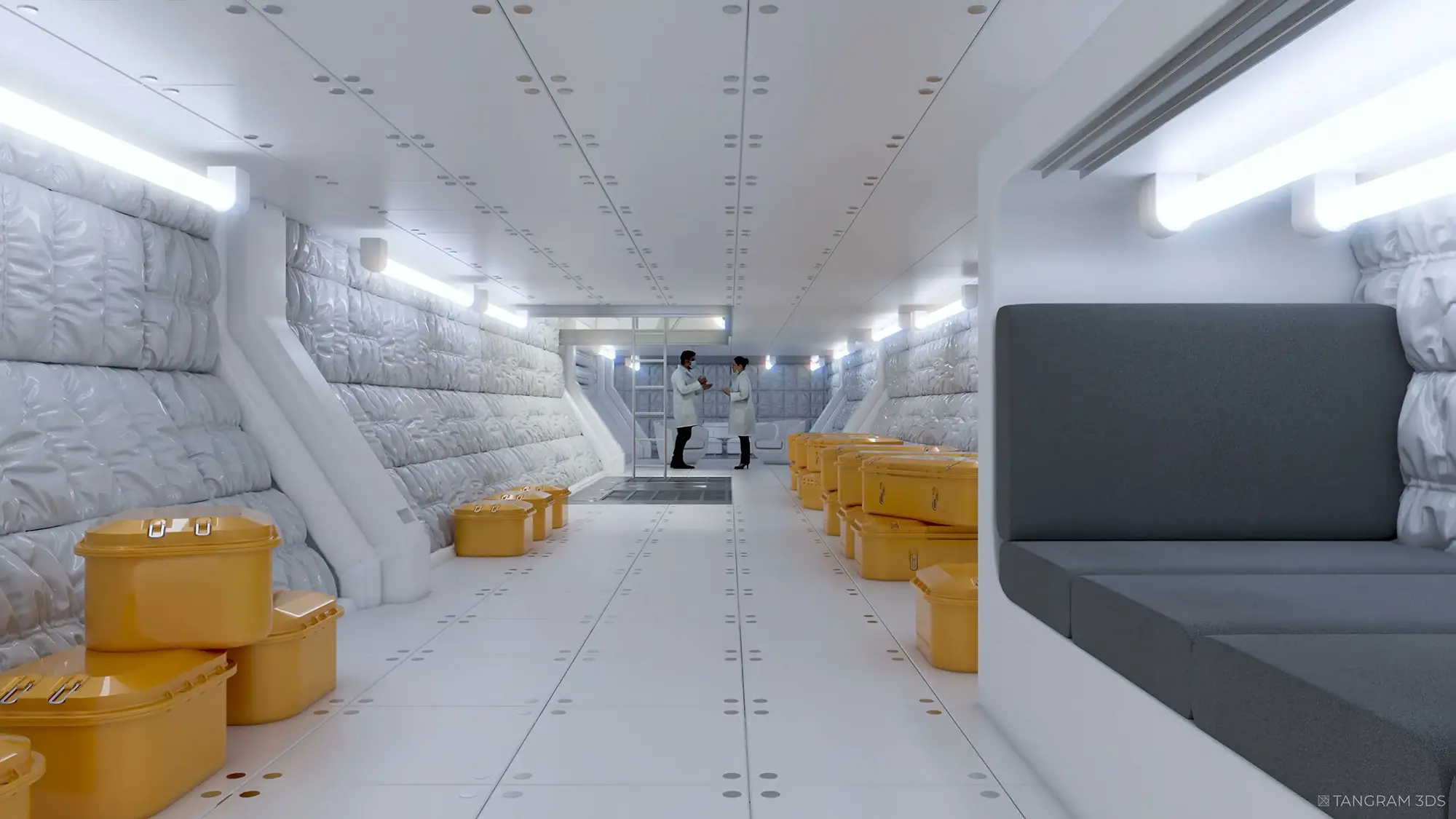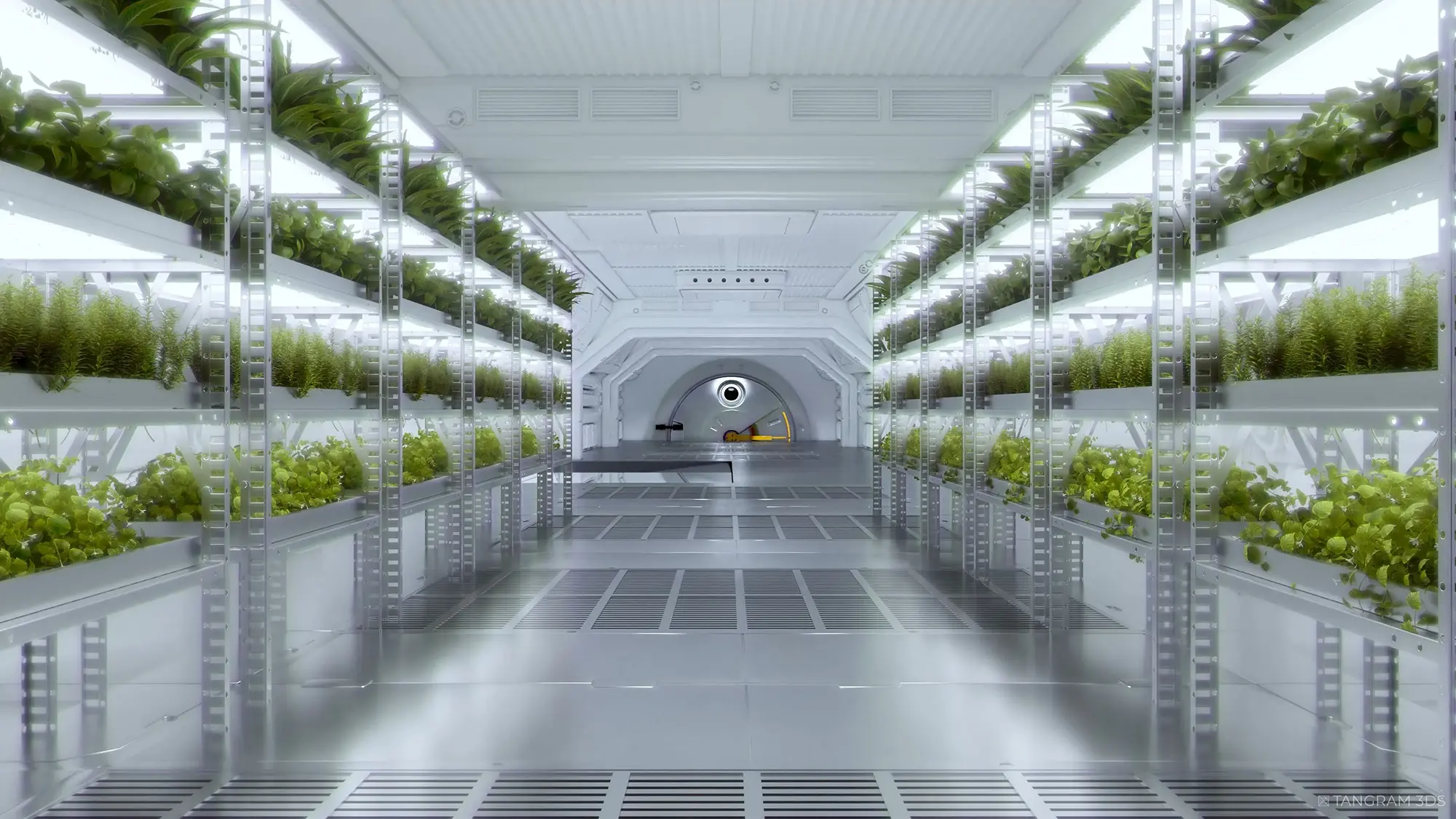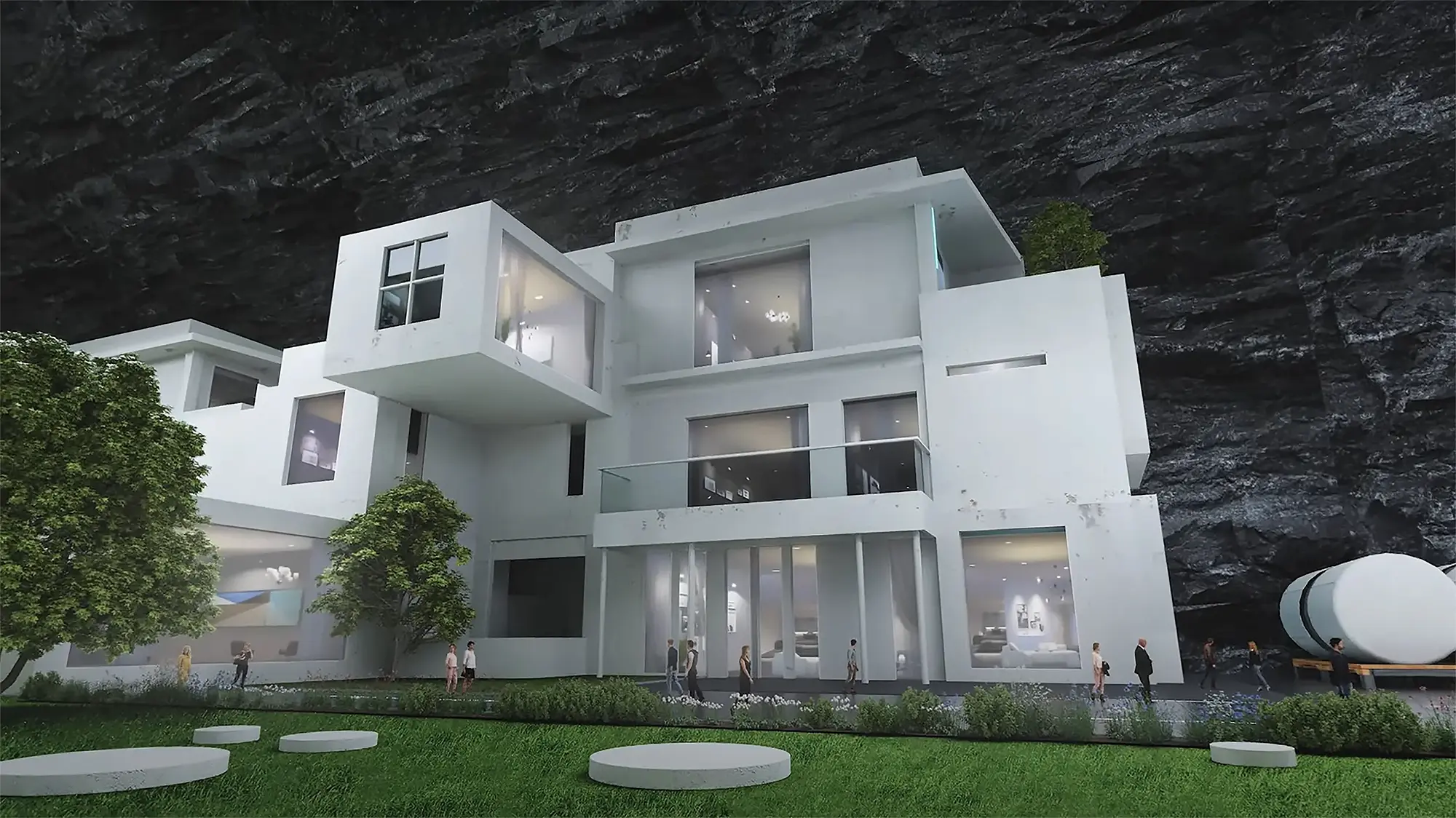

The Exploration Architecture Corporation (XArc), which designs space exploration architecture and conducts mission planning, has long had its eye on the moon and the potential it holds for expanding humanity’s presence in space. In collaborating with 3D artists, XArc founder Sam Ximenes wants to bring to life a vision for further exploration on the moon and eventually on Mars. His company has engineered systems for lunar landing pads constructed from bricks made of regolith (the loose dust and rock on the moon’s surface), established concepts for underground habitats where scientists can both live and conduct research, and designed spaceports to shuttle machinery and astronauts to these lunar bases and back.
To share that vision with the next generation of scientists, and to drum up the support to fund such incredible missions, XArc designers and engineers rely on their strong partnership with the team at Tangram 3DS to understand their concepts and translate them into engaging visuals. Together they are filling in the gaps between science and fiction and sharing their dreams of lunar colonies with the hopes of forging them into reality.
Leading the charge in designing and visualizing these out-of-this-world feats of engineering in 3D is Jacques Pena, the director of VRX at Tangram:
Our bread and butter is architecture visualization. From the arch viz standpoint we have experience in real-world construction efforts. Industrial, residential, you name it. We visualize things that don’t yet exist for two primary purposes: to help with future problem-solving and to draw in support and funding. The same applies to lunar colonies. Of course, it comes with its own unique challenges.
Normally when working in the architectural visualization pipeline, a project comes with an abundance of photos, CAD drawings, elevations, and real-world references for design, materials, and construction. Working with the engineers at XArc presented a new challenge: to model machines, structures, and technology that are 100% conceptual. The process demanded a highly collaborative effort, pairing XArc’s engineering vision with Jacque's expertise in 3D visualization:
If I was fortunate, I was working from engineering blueprints or one of the small models used in the foundation’s educational programs for the more complex machinery. Everything needed to be functional. I was often given a description and concept. From there I had to work with Sam and his team to settle on a working skeleton and use what I knew about architecture and mechanical design to generate the basic form and function. Once we had gone back and forth on the framework, I needed to build it in 3D as it would be constructed in real life. It required functional details, moving parts, and fastenings that normally you don’t focus on since you don’t see them. It was important to maintain an authentic design. I needed to create something that felt believable and tangible. If it is too science fiction, it feels made up. It all had to be grounded in the real world.
Unlike science fiction, which often paints with broad and murky strokes for the sake of the plot (think ‘unobtainium’), today’s scientists need to find creative solutions to the problems native to transporting supplies out of our atmosphere. Unusual new modeling considerations for outer space fabrication like weight, material, style, and modularity all pushed Jacques to overcome the persistent challenge of how to do the most with the least. XArc has crafted new methods of web-weave-style frameworks for construction to reduce overall weight and allow automated assembly on-site. Not only is this incredibly helpful in reducing storage space and weight on the rockets transporting all the raw materials to the moon, but it reduces the risk of injury to construction crews while 238,900 miles from the nearest hospital. Replicating those unique methods meant Jacques needed to understand more about how the machines and structures were built and what materials were being used in their construction. “I got to learn a lot, probably too much, about building stuff on the moon. One of the most costly and challenging aspects of any exploration into space is weight. You can’t bring everything to the moon. When discussing what things were made of, we had to always factor that in. New ideas could mean a new, lighter material. With that came redesigning. Being flexible and agile with changing designs was hugely important as we worked together. “
That spirit of collaboration is a core value that Jacques appreciates about working with Sam Ximenes and the other designers with XArc. Jacques could bring his own design sensibilities and inspiration to the table. When developing temporary, inflatable lunar habitats Jacques knew the construction needed to be modular, light, and functional. The body of the habitat required a rigid skeleton to maintain its shape and durability; walls were designed to be inflatable to reduce the weight of the construction materials and make assembly easier. Jacques used basic shapes in order to build a model reminiscent of a caterpillar, with jointed segments and soft hexagonal curves. Inside, racks of greenhouse shelves illustrate how the interior could be used while open spaces leave room for viewers to imagine how other areas could be used for research and habitation needs. “The canister design of the cavern habitat is one that I believe most strongly in. It’s simple, modular, and functional. It felt the most tangible to me when all was said and done.”
In contrast to the conceptual design challenges of the habitats and technology being deployed to the moon and its caves, the moon’s surface presented aesthetic challenges. While we have an incredible amount of visual reference for the moon and it doesn’t present terribly tricky modeling challenges, it is not an especially beautiful landscape (though a planetary geologist might beg to differ). With a single light source and very little in the way of visual variety, Jacques needed to capture the detail of the surface and make it visually engaging while keeping in mind practical considerations like file size and rendering time. “I wanted to make something that looked like a shot from the film ‘Moon’ starring Sam Rockwell. We had a lot of angles, some very wide shots of the landscape, and trying to get a well-balanced displacement to cover all of it at once was far too demanding on the scene. To prevent repeating textures or having to settle on something low-resolution I pivoted to a more modular technique.”
Jacques created a low poly environment as the landscape’s base to provide the backbone of the scene. Referencing 3D storyboards, Jacques modeled separate pieces of the background with varying levels of geometry in order to achieve high levels of detail at various camera distances as the storyboards dictated. Details had to be localized with high-resolution maps that could be relocated and edited specifically for different shots. Once the modular displacement sections were completed, Jacques relied on the use of the Forest Pack plugin (IToo Software) to populate the terrain with rocks and debris.
The collaborative development of the XArc and WEX projects has its feet in two worlds: visualizing unknown technologies and making those visions feel attainable. Working together, the artists at Tangram 3DS and the designers at XArc are uncovering new avenues to visualize these dreams. At the time of this writing, NASA’s Artemis-I mission has successfully launched the Orion spacecraft into lunar orbit. It is our first adventure back to the moon since 1979 and will help forge the path for the first human missions to Mars. 3D artists have new and endless roles to play in what is now shaping up to be a space race with competing players hailing from government-funded spheres as well as private, and commercial sectors.
By visualizing designs and construction in 3D, engineers save time and money without having to mockup something that will need to be rebuilt. 3D visuals can also help sell the dream of people like Sam Ximenes and inspire investors and generate support to help make those dreams a reality. Tangram’s success with WEX is the result of open collaboration. Not just between 3D artists and engineers but in many disciplines such as motion graphics, video production, and audio design. It would not be the same final product without all of the involved parties listening and learning from each other with open minds and an eagerness to share knowledge with one another. I asked Jacques his thoughts on the scope and impact of Tangram 3DS’ work on this extraordinary vision and he had these final thoughts:
...the future of how we gather resources, colonizing new places to live beyond our planet, and continuing expansion of human exploration into the stars begins with what we do on the moon. Technology is evolving and the direction it takes us not only as a species but as 3D artists in the future is astronomical. A much grander experience than the standard arch viz project. It’s vital. The possibilities are endless.
Lighting Up the Moon
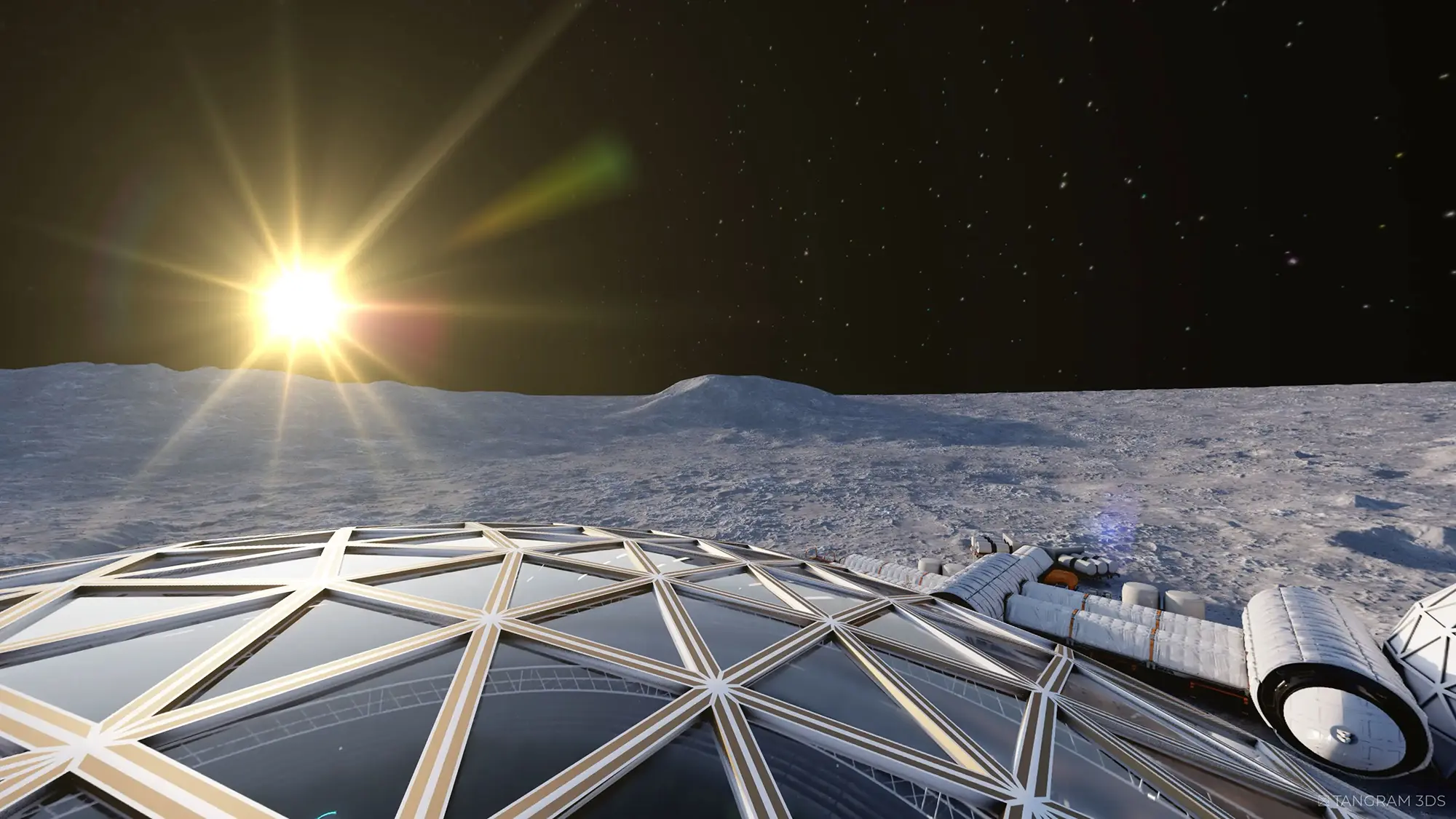
Modeling the moon is only half of the battle as Jacques discovered a new lighting challenge before him. “Here’s what sucks about the moon…there is no atmosphere, there is no GI, and only one key light: the Sun. I had to find the right compromise between what is realistic and accurate lighting on the moon with creating something more visually appealing.”
Leveraging Vray as his rendering engine, Jacques needed to both recreate the reality of the moon’s surface and give it a cinematic edge that captured the imagination of viewers. Starting with the sun as the key light he needed to fill where normally the atmosphere and global illumination would help balance the lighting. Jacques strategically placed filler lights where necessary, pushing beyond what is realistic for a more cinematic look. “This was a situation where reality surrenders to practicality.” The end result is one that shares the hard shadows and one-directional light you would see on the moon, without becoming flat.
Some Assembly Required
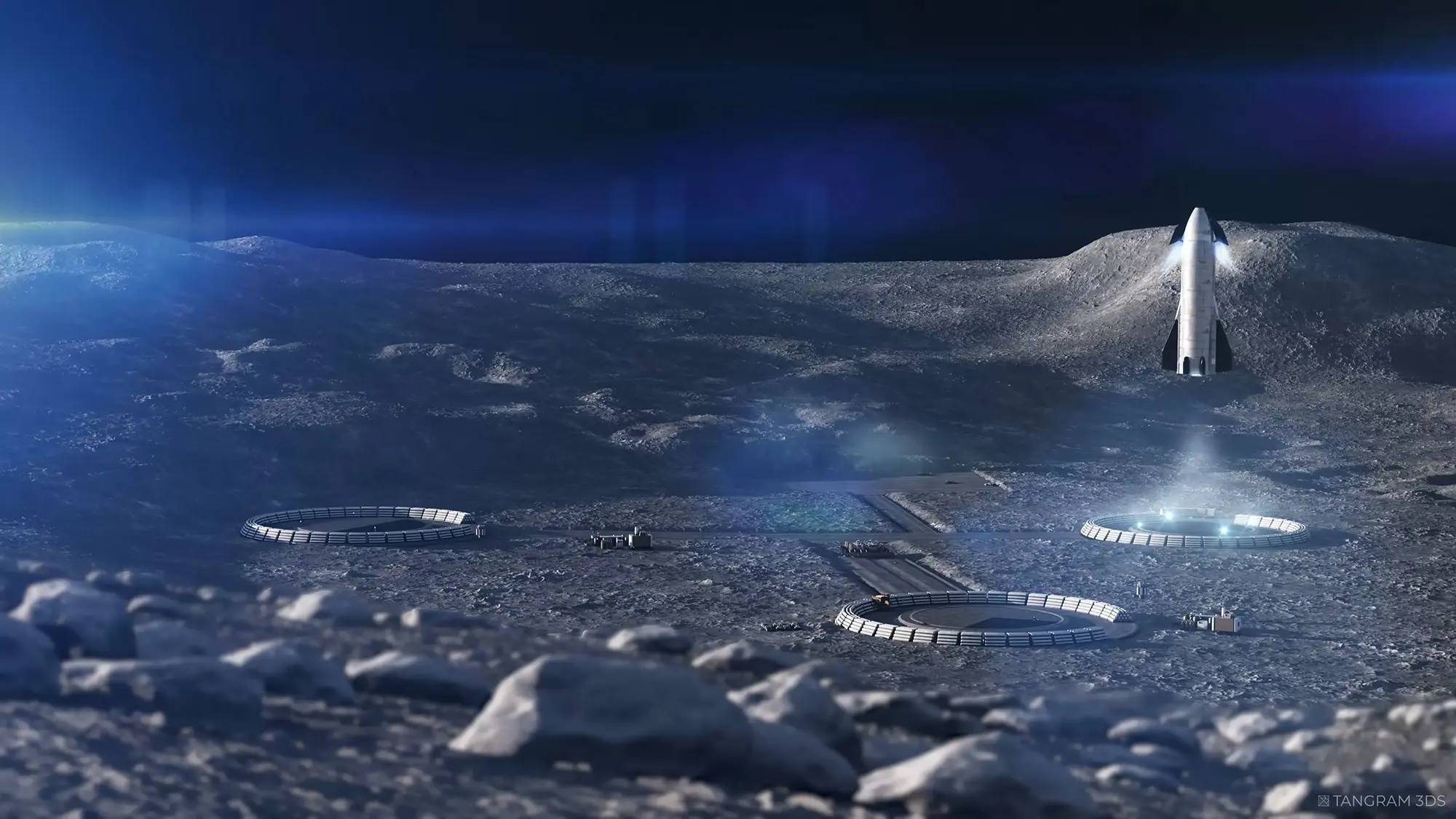
Assembling the renders and animations into a narrative production was led by Marc Fagan, the Director of Film and Motion at Tangram 3DS.
...the opportunity to work on a project that gave me a lot of creative freedom and the chance to use more particles and sci-fi effects was really fun. I pulled a lot of inspiration from video games and movies for the motion graphics to find the right kind of subtle science-fiction flair. It was cool to get to work on this because I’ve often wondered why we stopped going to the moon.
Marc’s goal was to assemble a story out of six separate videos between several XArc and WEX projects into one cohesive trailer. “Sam (Ximenes) wanted to divide the story into two parts: involvement in space and lunar habitation. Aside from that, we had a lot of creative freedom to develop the script and direction of the trailer.” The dual themes of the project were a proud appreciation for the achievements of the past and a steadfast optimism for the future of space exploration. To enhance the visuals, he leveraged the Plexus plugin, particle effects, and 3D element layers to create a dazzling transition from an ethereal cosmic cloud through a digital field that fades to an old-fashioned TV broadcasting the Apollo 11 launch.
To create an establishing shot of the moon, Marc could not rely on getting a render. He needed to create those shots directly in After Effects using a mix of plugins.
The script was changing all the time and we didn’t have the resources to do all our effects shots in 3D. For all the far shots of the moon, I used the Orb element from video copilot. I combined them with photography of our planet from orbit to composite our establishing shots. The orb element was incredibly useful to quickly map a high-resolution map of the moon and set up shots in space without taking time away from rendering.
Synthesizing the Sound of Space
Tangram 3DS CEO and founder Stefan Vittori reached out to his friend, composer, and audio designer Andreas Frei to give the trailer a gripping soundtrack and audio design. Andreas has worked as a composer and sound designer for over 20 years on projects such as Rubikon, Manaslu - Mountain of Souls, and Streif - One Hell of a Ride
It is my conviction that audio is half of the cinematic experience. My process always starts with the music… I sit down with my piano to find the overall structure. The music had to evolve and be a throughline of the story. I wanted to produce something enveloping and immersive, not yet in existence but not very far away either.”
Andreas used the original Korg MS20 analog monosynth keyboard to create many of the retro-synth squiggly-sounds, and electronic beats. He used his Roland MKS80 sequencer for the diaphanous ambiance to enhance the sense of immersion into the vast depths of space.
I used Nuendo and Pro Tools to put together the orchestral and synthetic sounds. Nuendo is great because it is so easy to mix and integrate it and Atmos with instrumental plugins. … I use many plugins but my favorite on this project was the Spectrasonics Omnisphere. It’s very versatile and just has so many sounds to pull from....I’m always keeping in mind the use of immersive sound; the small details keep you in the experience. I mixed the soundtrack with the effects using Dolby Atmos technology to make the whole experience an immersive 3D one. I was inspired by the visuals and my goal was that embracing each other’s strengths can help make our production richer. I embraced that 3D aspect and open feeling in the sound to make it all feel as one.
See our XArc and WEX case study to find out more about how Tangram 3DS is helping to shape the future of human space exploration.
More News from Tangram 3DS

Rooftop Amenities: An Exclusive Experience With Enhanced Opportunities

Looking Ahead: Luxury Residential in 2024

For Industrial Markets, Smaller Networks Yield Bigger Returns



